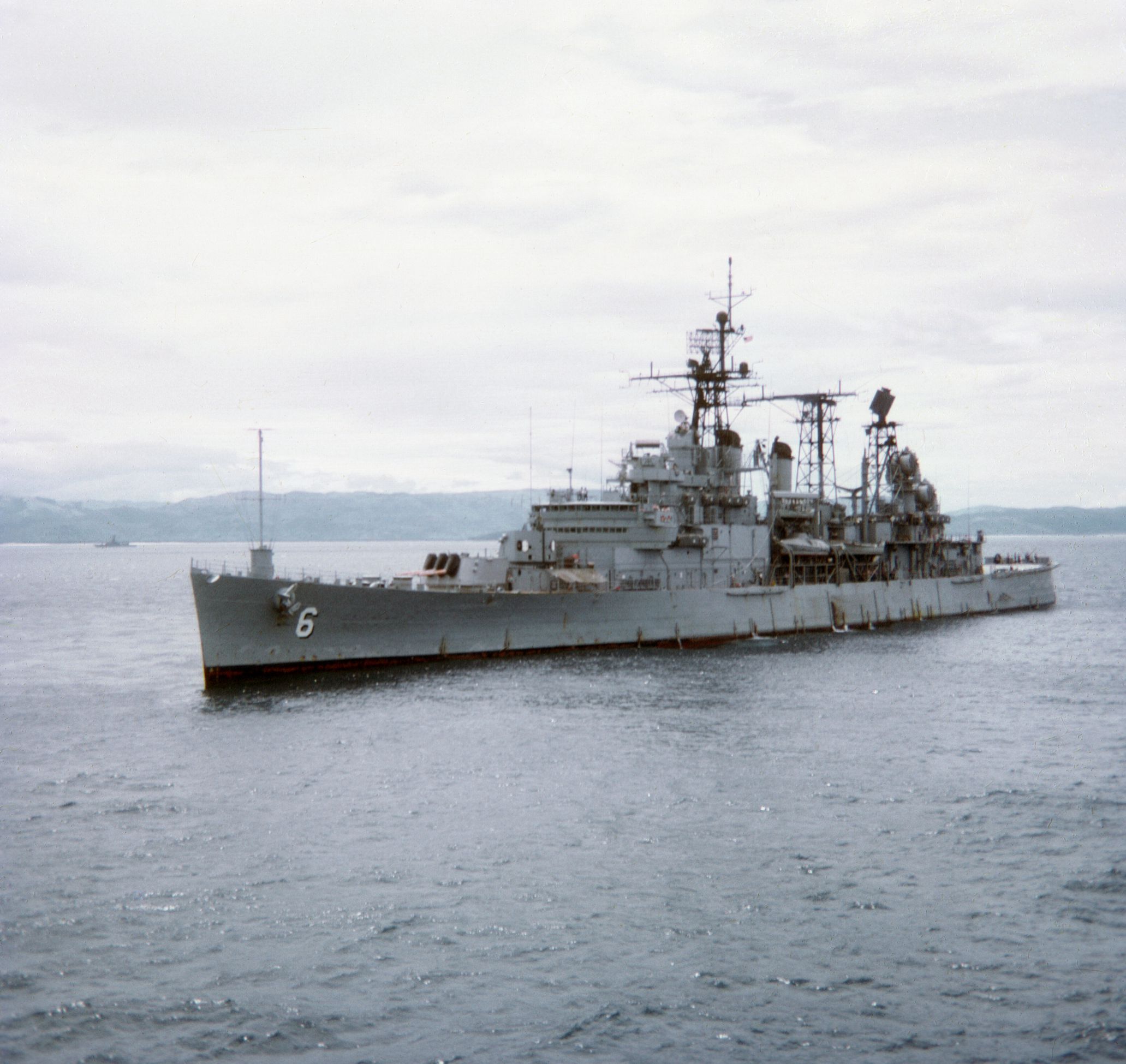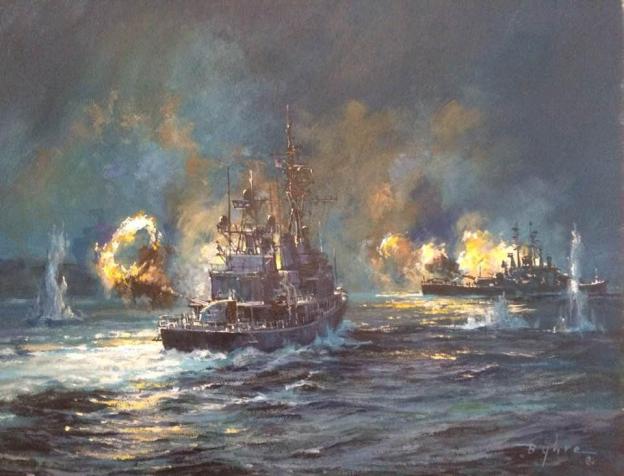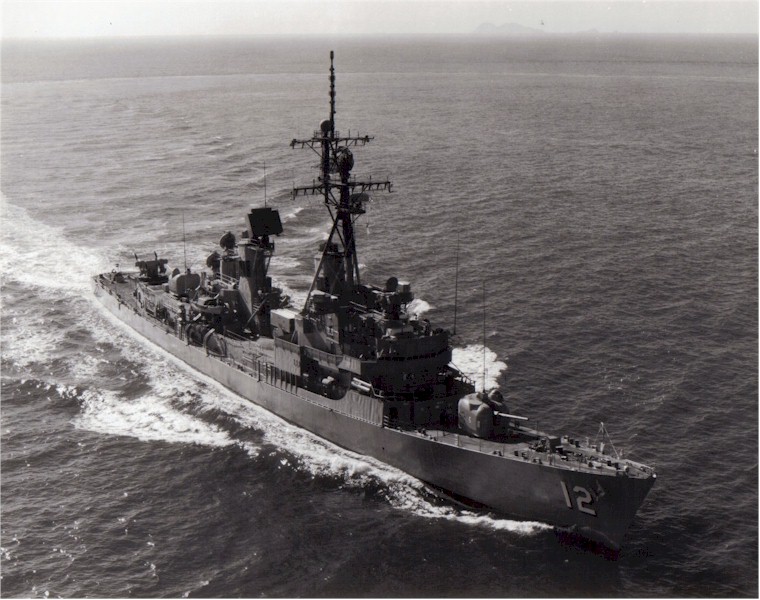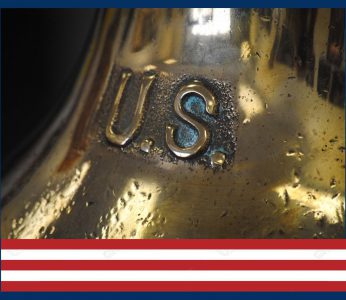Story expanded on from “Striking Eight Bells: A Vietnam Memoir.”
“Another story on what most Americans don’t know about the Navy’s role in the Vietnam War?”
Many Americans probably believed that by 1972, the war in Vietnam was essentially winding down. However, for the U.S. Navy in Vietnam, 1972 would prove to be a busy year of conducting numerous and dangerous combat operations.
On August 27, 1972. Operation Lion’s Den, or the Battle of Haiphong Harbor, occurred, which involved one of the few ship-to-ship naval battles of the Vietnam War. The operation was carried out by four ships designated as Task Unit 77.1.2., which included USS Newport News (CA 148), an 8-inch gun cruiser; USS Providence (CLG 6), a 6-inch gun missile cruiser; USS Robison (DDG 12), a guided-missile destroyer; and USS Rowan (DD 782). Admiral James L. Holloway III, the Seventh Fleet commander, also participated as an observer on Newport News.

The two cruisers and two destroyers conducted a brief night raid against the North Vietnamese forces protecting the port of Haiphong. This operation was a naval gunfire strike against targets in Haiphong, Do Son Peninsula and Cat Ba area. The purpose of the raid was to knock out coastal defense and SAM (surface-to-air missile) sites as well as other military targets in the vicinity of Haiphong Harbor or the “Lion’s Den,” as called by the Navy.


Vietnamese coastal defense gunfire were heavy during the attack. Newport News reported 75 rounds of very accurate hostile fire; Rowan reported 50 rounds of accurate fire as close as 20 yards and straddling the ship. Robison reported 140 rounds of very accurate fire, the closest being 15 yards off the port beam. Providence counted 60 incoming rounds.


Newport News ceased firing at 2333 and prepared to egress from the area. Captain Zartman the Commanding Officer of Newport News, informed Holloway that all of the ship’s targets “had been covered” and that secondary explosions were noted at Cat Ba airfield and an ammunition dump. A short period after cease fire, Combat Information Center (CIC) reported a surface target, designated Skunk Alpha, at 10,000 yards bearing 088 degrees, heading for Newport News at high speed.”
P-6-class Soviet-manufactured fast patrol boats had waited to ambush Newport News in the vicinity of Ile de Norway. Numerous rocks and pinnacles near the island made it difficult for Newport News’ radars to lock onto the patrol boat. The patrol boat’s relative bearing was also dead ahead, making it impossible for the cruiser’s 8-inch guns to fire a low angle shot (an electronics antenna on the forecastle blocked such shots).
Newport News swung hard to the starboard to unmask the battery and commence firing. Within minutes, the contact appeared to be on fire. CIC then informed the bridge of two additional patrol boats 16,000 yards dead ahead. Newport News came hard port to bring its guns to bear on the new targets—a heading that now put the ship on a collision course with the shoals of Ile de Norway.
The zigzagging approach of the patrol boats combined with darkness and the confusing effect of the cruiser’s own fire made it difficult for the 21,000-ton ship to sink these tiny targets. When a call came in from Providence about a possible fourth contact, Holloway told Zartman that he was going to call in air support. “Attention any Seventh Fleet aircraft in the vicinity of Haiphong,” Holloway announced on a special Navy frequency reserved for such emergencies, “This is Blackbeard (Seventh Fleet Commanders’ personal call sign) himself aboard USS Newport News with a shore bombardment force in Haiphong Harbor. We are engaged with several surface units and need some illumination to help us sort things out.”[2][3]…To read “Striking Eight Bells,” use one of these links to booksellers: Amazon.com: Books, Barnes and Noble Booksellers, BAM –Books A Million, Smashword.com eBooks, goodreads and Thriftbooks.

©2018 George Trowbridge
The stories in these posts and the book; “Striking Eight Bells: A Vietnam Memoir,” reflect the author’s recollection of events. Some names, locations, and identifying characteristics have been changed to protect the privacy of those depicted. Dialogue has been recreated from memory. Dates, times, and locations were recreated from declassified U.S. Navy records and others. Photographs used are either public domain or owned by the author. Illustrations and maps used were either created by the author or in the public domain. The stories in these posts and the book are solely the opinion of the author and not the publisher, Richter Publishing, LLC.
*Image was found in public domain or it could not be established after reasonable search, that any claim existed to the image. Image used for illustrative purposes only and is not the property of the author. Where ever possible credit for the image is indicated in the caption.
1. Marine Art By Dale Byhre. https://marineartbydale.com/ Print title; “When Lightning Followed Thunder.”
2. U.S. Naval Institute’s Naval History Blog (navalhistory.org). Naval Bombardment: Into the Lion’s Den. https://www.navalhistory.org/2011/08/27/naval-bombardment-into-the-lion%E2%80%99s-den
3.Aircraft Carriers At War Chapter 17 By Admiral James L. Holloway III. http://www.uss-newport-news.com/hist/lions_den_chap_17.php

I think we swamped a couple of those fast boats they sent after us that night – and yes – the Robison did get a lot of loving attention from the shore batteries. Some of the rounds were popping right off the side and several actually went right over us – sounded like a freight train. good times.
LikeLike
Hello,
Is there any mention in your book “Striking Eight Bells: A Vietnam Memoir” of the destroyer USS Brush DD-745?
Thanks in advance for your assistance.
Howard
LikeLike
No, Sorry I didn’t mention Brush DD-745. The ships I do mention in the book are those that USS Rich DD 820 operated with as recorded in our ship’s deck logs and from my recollections.
LikeLike
How about the Kraus, DD849?
LikeLike
Johnny Carmack, I found no information that the USS Richard E. Kraus (DD 849) was involved in this particular operation. I remember the Kraus being in Vietnam from about November 72 through early 1973. Do you have information otherwise regarding this operation?
LikeLike
negative. As a very, very young BM2 I wasn’t involved or interested in anything other than my job. My interest stems from my attempts at reconstructing that part of my past history. I know what I did but little of what everyone else did. Guess I’m just trying to satisfy a longing for understanding as to my place and involvement in history.
LikeLike
I was a QM on the bridge of Uss Newport News the night of Aug. 27, 1972. The first indication of PT boats came by way of Mstr. Chief QM Williams. We were navigating by radar and the chief was using radar ranges to a small island as a navigational aid.He all of a sudden muttered ” my island just got underway” The info was past to the CO and communicated to look outs and CIC. The fight was on. I have the complete attack and running gun battle on a recording. What I have just stated can be verified twice on this recording. I was hand recording the radar ranges and relaying them to QM 1 Mitch Rybczyk who plotted them on the chart. It was quit a night that feels like yesterday. I am 70 yr. old now, retired, and sometimes can”t remember what I had for breakfast. But that night and Oct. 1,1972 { T-2 explosion} were last night to me. BOB GOODLIN QM. USS NEWPORT NEWS CA 148
LikeLike
I was serving in the aft fire room of the Rowan that night, wearing a headset, so I heard about the torpedo boats faster than the rest of the fire room. I did not realize just how serious the night had been until I read Chuck Packer’s account of that night. I found it highly ironic that the Rowan survived that night, only to sink after being deccomissioned…Rowan decommissioned at 32nd St Naval Base in San Diego, California, on 18 December 1975, was struck from the Navy List on 30 January 1976 and was transferred to the Republic of China on 1 June 1977. While under tow to Taiwan, the destroyer ran aground on 22 August 1977. Written off as a total loss, the wreck was later salvaged for parts
LikeLike
Any one reading hear serve on the USS Charles P. Cecil?, DD-835, 1972, Tonkin Guf Yatch Club. BT-3, B-1
LikeLike
Served aboard the USS Wiltsie DD716. 72 and to the end of January 73 where can I get a copy of “Striking Eight Bells? Seen action in the Tonkin Gulf Hon La Island and Ho Long Bay.
LikeLike
Mick,
There are links on my website to the various book sellers at the bottom of almost every page or post on the site. Also here are the links to my book on Amazon, Books-A-Million, Barnes and Noble, Smashwords, Thriftbooks and Goodreads websites:
https://read.barnesandnoble.com/book/striking-eight-bells-a-vietnam-memoir/cover
http://www.booksamillion.com/search?id=7210444658944&query=9781945812330&filter=product_type%3Abooks
https://www.barnesandnoble.com/w/striking-eight-bells-george-trowbridge/1128022155?ean=9781945812330
https://www.smashwords.com/books/view/795264
https://www.thriftbooks.com/w/striking-eight-bells–an-uneasy-time-for-america/18857654/#isbn=1945812338&idiq=26107734
https://www.goodreads.com/book/show/44143614-striking-eight-bells
LikeLike
I was a ETN3 aboard the USS Rowan on that night. My General Quarters station was as a phone talker in the Radar equipment room. I have two of the books. In addition to coverage of the Battle there is a decent description of life in the US Navy in the early 1970’s.
LikeLike
I was a GMT3 onboard the USS ROWAN DD-782 that night and stationed in the ASROC Control Station.Our Job was to Fire SHRIKE Missles that were recently outfitted ontop of our ASROC Launcher..When the attack began we were given the order to fire.GMT2 Rich Havilland fired the first SHRIKE Missle and a couple minutes later I fired the second.As far as I know it was the first time ever SHRIKE Missles we’re fired from such a platform.Everything seemed fine until suddenly the word came that High Speed Surface Contacts were bearing down.Our 5″ 38 Gun Mounts were firing rapid continuous ,the ship was making rapid turns from port to starboard..Then the word came of incoming Air Contacts..Yes Sir it was Quite a Night to Remember!!
LikeLike
I was a GMG2 and the gun captain of the left gun in the 6” turret on USS Providence CLG-6. During the run into and out of Haiphong Harbor around midnight we commenced 60 seconds of rapid and continuous fire all the while receiving reports of counter-battery fire from shore artillery. It was reported that 3 enemy patrol boats were sent out to engage the U.S. ships involved, but they were neutralized by naval air support.
LikeLike